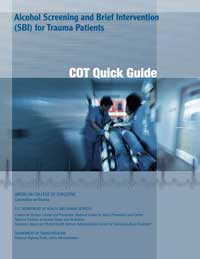Screening, Referral Tools Available Online
A new SAMHSA Web site—www.sbirt.samhsa.gov—is offering updates and news about the Agency’s screening initiative.
 The Web site supports SAMHSA’s Screening, Brief Intervention, Referral, and Treatment (SBIRT) program. The national initiative is funded by SAMHSA’s Center for Substance Abuse Treatment (CSAT). (See SAMHSA News online, January/February 2006.) The Web site supports SAMHSA’s Screening, Brief Intervention, Referral, and Treatment (SBIRT) program. The national initiative is funded by SAMHSA’s Center for Substance Abuse Treatment (CSAT). (See SAMHSA News online, January/February 2006.)
The SBIRT site—home to a complete set of program-related tools—adds another facet of support to SAMHSA’s screening and treatment efforts. “This new site will allow grantees across the Nation to have immediate access to SBIRT resources,” said Tom Stegbauer, M.B.A., Lead Public Health Analyst at CSAT’s Division of Systems Improvement. “We continue to focus on helping programs provide patients with access to treatment.”
Back to Top
Access to Resources
The new Web site has various resources for SBIRT grantees, including training manuals, links to organizations and publications, and a list of references. In addition, members of the public can learn more about the initiative by viewing the site’s news updates and answers to frequently asked questions.
The SBIRT site will be updated as more tools, resources, and information become available. To access program resources, or obtain more information on the initiative and its grantees, visit www.sbirt.samhsa.gov. 
Back to Top
What Is SBIRT?
SAMHSA’s Screening, Brief Intervention, Referral, and Treatment (SBIRT) initiative delivers early intervention and treatment services to people with or at risk for substance abuse disorders.
Screening is done by peer health educators in emergency rooms, trauma centers, and health clinics as people wait for services for other medical conditions. Friendly and nonjudgmental, the educators wear surgical scrubs just like other ER staff. Educators create “teachable moments” to encourage people to undergo screening. This process is particularly effective for those alcohol and drug users with nondependent substance abuse—a group the traditional system has largely ignored. 
Back to Top
What's New?
The SBIRT Web site recently posted a publication on alcohol screening in trauma centers.
 Excessive drinking is a risk factor for injury, and a high proportion of at-risk drinkers end up in trauma centers. Alcohol Screening and Brief Intervention (SBI) for Trauma Patients: COT Quick Guide is designed to help trauma centers screen at-risk patients. Excessive drinking is a risk factor for injury, and a high proportion of at-risk drinkers end up in trauma centers. Alcohol Screening and Brief Intervention (SBI) for Trauma Patients: COT Quick Guide is designed to help trauma centers screen at-risk patients.
Trauma center staff can use the guide’s helpful hints and ready-to-use screening instruments to take advantage of the teachable moment generated from an injury. Screening and brief interventions are associated with fewer hospital days and fewer emergency department visits.
The guide was prepared in part by the American College of Surgeons Committee on Trauma (COT) and SAMHSA’s Center for Substance Abuse Treatment. To access a PDF of the guide, visit http://sbirt.samhsa.gov/documents/SBIRT_guide_Sep07.pdf. 
Back to Top
SBIRT: Step by Step
SBIRT follows a three-step process.
Screen Patients
Screening quickly assesses the severity of substance use and identifies the appropriate level of treatment. It can be done through an interview and self-report. |
Conduct Brief Intervention
Brief intervention focuses on increasing a person’s awareness of substance use as well as encouraging changes in behavior. |
Refer to Treatment
Referral to treatment offers access to care for individuals who are in need of treatment for substance abuse.
SBIRT services can be used along with specialized and traditional treatment. Screenings take
place in trauma centers, emergency rooms, community clinics, health centers, and school clinics.
As of January 2007, SAMHSA grantees have screened more than 460,000 people. 
|
« Previous Article
Next Article »
Back to Top
|






